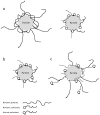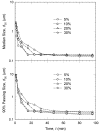Nanomilling of Drugs for Bioavailability Enhancement: A Holistic Formulation-Process Perspective
- PMID: 27213434
- PMCID: PMC4932480
- DOI: 10.3390/pharmaceutics8020017
Nanomilling of Drugs for Bioavailability Enhancement: A Holistic Formulation-Process Perspective
Abstract
Preparation of drug nanoparticles via wet media milling (nanomilling) is a very versatile drug delivery platform and is suitable for oral, injectable, inhalable, and buccal applications. Wet media milling followed by various drying processes has become a well-established and proven formulation approach especially for bioavailability enhancement of poorly water-soluble drugs. It has several advantages such as organic solvent-free processing, tunable and relatively high drug loading, and applicability to a multitude of poorly water-soluble drugs. Although the physical stability of the wet-milled suspensions (nanosuspensions) has attracted a lot of attention, fundamental understanding of the process has been lacking until recently. The objective of this review paper is to present fundamental insights from available published literature while summarizing the recent advances and highlighting the gap areas that have not received adequate attention. First, stabilization by conventionally used polymers/surfactants and novel stabilizers is reviewed. Then, a fundamental understanding of the process parameters, with a focus on wet stirred media milling, is revealed based on microhydrodynamic models. This review is expected to bring a holistic formulation-process perspective to the nanomilling process and pave the way for robust process development scale-up. Finally, challenges are indicated with a view to shedding light on future opportunities.
Keywords: drug nanoparticles; process modeling; process parameters; stabilization; wet stirred media milling.
Figures







References
-
- Lipinski C.A. Poor aqueous solubility: An industry wide problem in drug discovery. Am. Pharm. Rev. 2002;5:82–85.
-
- Singh S.K., Srinivasan K., Gowthamarajan K., Singare D.S., Prakash D., Gaikwad N.B. Investigation of preparation parameters of nanosuspension by top-down media milling to improve the dissolution of poorly water-soluble glyburide. Eur. J. Pharm. Biopharm. 2011;78:441–446. doi: 10.1016/j.ejpb.2011.03.014. - DOI - PubMed
Publication types
LinkOut - more resources
Full Text Sources
Other Literature Sources
Miscellaneous

